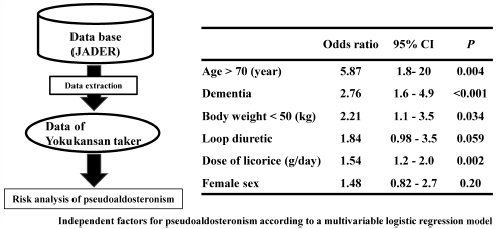- 著者
- Tomoaki Ishida Kei Kawada Shumpei Morisawa Kohei Jobu Yasuyo Morita Mitsuhiko Miyamura
- 出版者
- The Pharmaceutical Society of Japan
- 雑誌
- Biological and Pharmaceutical Bulletin (ISSN:09186158)
- 巻号頁・発行日
- vol.43, no.10, pp.1570-1576, 2020-10-01 (Released:2020-10-01)
- 参考文献数
- 24
- 被引用文献数
- 1 18
Yokukansan is a Kampo formula that is commonly used by the elderly because it is expected to improve peripheral symptoms of dementia and delirium. However, side effects from its use are frequently reported in the elderly. In particular, pseudoaldosteronism caused by the licorice contained in yokukansan leads to hypertension, hypokalemia, and muscle weakness, which may result in death. This study aimed to identify the risk factors of pseudoaldosteronism with yokukansan use. Using cases reported in the Japanese Adverse Drug Report (JADER) database, the reporting odds ratio (ROR) was calculated and compared to assess the risk of pseudoaldosteronism for each licorice-containing Kampo formula. We also analyzed the risk factors for pseudoaldosteronism in patients taking yokukansan. Yokukansan (ROR 2.4, 95% confidence interval (CI) 1.9–2.8; p < 0.001) had a higher risk of pseudoaldosteronism than that of other licorice-containing Kampo formulas. Furthermore, the results of a logistic regression analysis in patients taking yokukansan showed that the licorice dose (OR 1.5, 95% CI 1.2–2.0; p < 0.01), older age (<70 years, OR 5.9, 95% CI 1.8–20; p < 0.01), dementia (OR 2.8, 95% CI 1.6–4.9; p < 0.001), low body weight (<50 kg, OR 2.2, 95% CI 1.1–3.5; p = 0.034) were risk factors for pseudoaldosteronism, Although not significant, treatment with loop diuretics (OR 1.8, 95% CI 0.98–3.5; p = 0.059) tended to increase the risk of pseudoaldosteronism. In summary, patients must understand the risk factors when considering taking yokukansan and reduce the licorice dose they consume.
- 著者
- Yasuyo Morita Tomoaki Ishida Shumpei Morisawa Kohei Jobu Yangran Ou Hiroko Fujita Kazuhiro Hanazaki Mitsuhiko Miyamura
- 出版者
- The Pharmaceutical Society of Japan
- 雑誌
- Biological and Pharmaceutical Bulletin (ISSN:09186158)
- 巻号頁・発行日
- vol.44, no.1, pp.32-38, 2021-01-01 (Released:2021-01-01)
- 参考文献数
- 34
- 被引用文献数
- 5
Sarcopenia is a disease whose symptoms include decreased muscle mass and weakened muscle strength with age. In sarcopenia, decreased production of insulin-like growth factor-1 (IGF-1) increases ubiquitin ligases, such as Atrogin1 and Muscle RING-Finger Protein-1 (MuRF1), by activating forkhead box O (FOXO), and inflammatory cytokines and oxidative stress increase the expression of ubiquitin ligases by activating the transcription factor nuclear factor-kappa B (NF-κB). In addition, increased levels of ubiquitin ligases cause skeletal muscle atrophy. Conversely, sirtuin 1 (Sirt1) is known to regulate the expression of ubiquitin ligases by suppressing the activities of NF-κB and FOXO. In this study, we evaluated the effect that juzentaihoto hot water extract (JTT) has on skeletal muscle atrophy and motor function by administering it to senescence-accelerated mouse prone-8 (SAMP8). The group treated with JTT displayed larger gastrocnemius muscle (GA) and extensor digitorum longus (EDL) weights, larger GA muscle fiber cross-sectional areas, and motor function decline during rota-rod tests. JTT also increased IGF-1 serum levels, as well as mRNA Sirt1 levels in GA. Serum levels of tumor necrosis factor-α, interleukin-6, and mRNA levels of Atrogin1 and MuRF1 in GA were reduced by JTT. The muscle fiber cross-sectional area of GA was correlated with the mRNA levels of Sirt1 in GA. The results of this study suggested that JTT administration suppresses skeletal muscle atrophy and motor function decline in SAMP8 mice. This effect may be associated with the increased expression levels of Sirt1 and IGF-1 by JTT.
- 著者
- Tomoaki Ishida Michiro Iizuka Yanglan Ou Shunpei Morisawa Ayumu Hirata Yusuke Yagi Kohei Jobu Yasuyo Morita Mitsuhiko Miyamura
- 出版者
- The Pharmaceutical Society of Japan
- 雑誌
- Biological and Pharmaceutical Bulletin (ISSN:09186158)
- 巻号頁・発行日
- vol.42, no.7, pp.1128-1133, 2019-07-01 (Released:2019-07-01)
- 参考文献数
- 33
- 被引用文献数
- 7
In diabetic patients, skeletal muscle atrophy occurs due to increased oxidative stress and inflammation. Skeletal muscle atrophy reduces the QOL of patients and worsens life prognosis. Therefore, development of preventive therapy for muscle atrophy in hyperglycemic state is eagerly awaited. Juzentaihoto is a medicinal herb that has a function to supplement physical strength, and it is expected to prevent muscle atrophy. To determine the preventive effect of juzentaihoto on muscle atrophy in hyperglycemic state, streptozotocin (STZ) was administered to induce diabetes in mice and the preventive effect of juzentaihoto was evaluated. Mice that received juzentaihoto extract (JTT) showed that the decrease in muscle fiber cross-sectional area in the gastrocnemius muscle was reversed. Additionally, the expression level of tumor necrosis factor α (TNF-α), an inflammatory cytokine, in serum decreased, and that of ubiquitin ligase (atrogin-1, muscle RING-finger protein-1) mRNA in skeletal muscle decreased. An anti-inflammatory cytokine interleukin-10 showed increased levels in the serum and increased levels in spleen cell culture supernatant collected from mice that received JTT. JTT had no effect on the blood glucose level. These results suggest that prophylactic administration of JTT to STZ-induced diabetic mice affects immune cells such as in spleen, causing an anti-inflammatory effect and inhibiting excessive activation of the ubiquitin-proteasome system, to reverse muscle atrophy.


